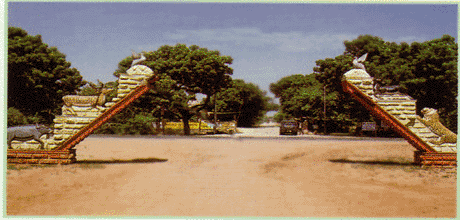
This bird paradise acquired its name – Keoladeo because of the existence of the Keoladeo temple of Lord Shiva. After the name of this temple the lake is called ‘Ghana’ Keoladeo. Ghana being the vernacular synonym for dense forest. It was known as the best duck shooting resort during the British reign, but was declared a reserve for birds in 1956 and
later upgraded to a National Park. UNESCO has listed it as a world heritage site.
The geographical location is ideal, as it is on the main north-south avian route of India. Although small in size (only 29 sq. kms), it has over 375 species of beautiful birds, and more than 132 of these breed inside the Keoladeo Ghana National Park. Almost every year, new species are added to the list. The Bird Sanctuary not only attracts birds from allover India, but also from far off Europe, Siberia, China and Tibet.
Before the monsoons, hundreds of these exotic birds roost and nest here, and building activities start on the ‘babool’ and ‘kadam’ trees of the park. Water, flowing through the Ajan Bandh starts filling the various ponds and lakes of the Park. When assured of enough food, hundreds of large, medium and little cormorants, darters, purple and grey herons,
various species of egret, white-necked as well as black-necked storks, white ibis, spoonbills, night herons and other birds get busy courting and mating. The trees are overloaded with nests - a single tree houses approximately fifty to sixty nests – belonging to different species of birds looking after their young ones.
Saras cranes, the tallest flight birds, nest in exposed and open areas; both partners
share the duty of hatching; while changing incubating duties, they come together, raise
their neck and give out shrill trumpeting calls in unison, fanning their feathers at the same time.
The newborn chicks are only 10 cm. in size but grow up to one metre in height within a year.
As the monsoon arrives, birds from every part of the country start flying into the Park. Migratory waterfowls, including the pride of keoladeo – the Siberian Cranes, form an interesting species found in the Park. These waterfowls visit the Park in hordes during the month of October. The rosy starling marks the beginning of the arrival of migratory birds. The most noticeable waterfowls coming to the Park are the bar-headed and greylag geese. The ducks spotted here are pintail, common teal, ruddy shelduck,
mallard, widgeon, shoveler, common shelduck, red crested
pochard, gadwall etc. predatory birds like the imperial eagle, steppe
and tawny eagle, spotted eagle, marsh harrier and laggar falcon are attracted
towards the Park, completing the avian food chain of the ecosystem. Some of them,
like the shorttoed eagle, lesser spotted eagle and shikra, are the residents of the Park.
About 11 sq. kms of the Park is covered by water; the remaining portion is rich in birds like the kingfisher, red vented and white-cheeked bulbuls, babblers, quails, partridges, sunbirds, sparrows, parakeets and orioles, which live in bushes and burrows. These winged beauties carry on their activities all the year round, thus making this Park a pilgrimage for bird lovers and an ornithologist’s delight.
Animals like the black buck, sambar-the largest Indian antelope, spotted deer,
and nilgais also show their presence here, though they are greatly outnumbered by the
winged fraternity. Pythons can also be observed, at some places, lazing in the sun.
|